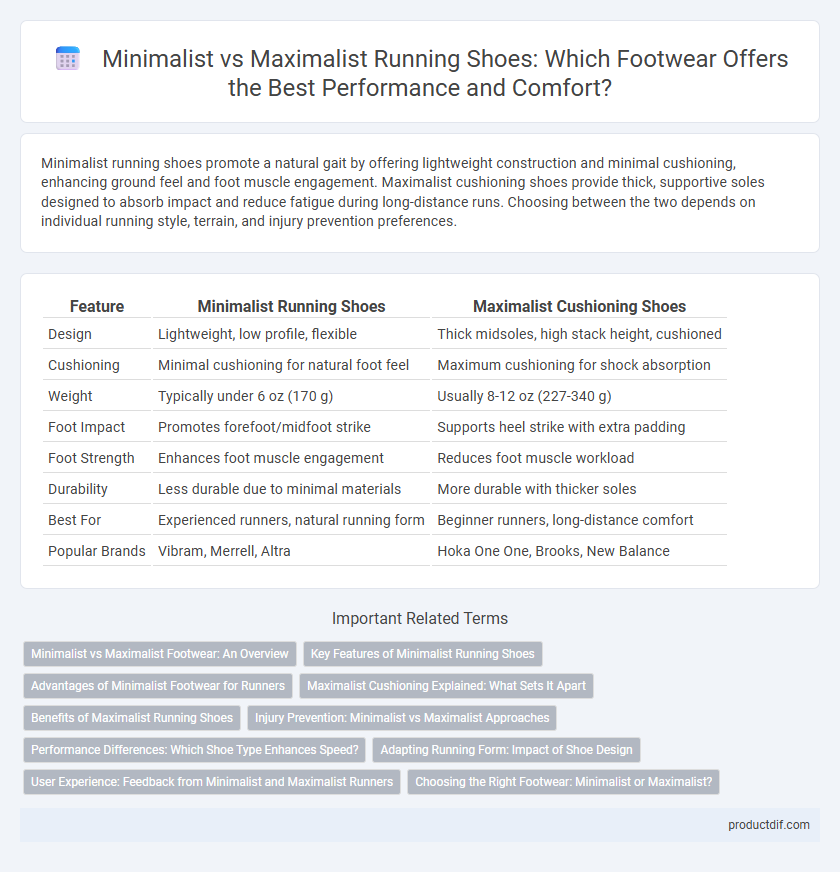Minimalist running shoes promote a natural gait by offering lightweight construction and minimal cushioning, enhancing ground feel and foot muscle engagement. Maximalist cushioning shoes provide thick, supportive soles designed to absorb impact and reduce fatigue during long-distance runs. Choosing between the two depends on individual running style, terrain, and injury prevention preferences.
Table of Comparison
| Feature | Minimalist Running Shoes | Maximalist Cushioning Shoes |
|---|---|---|
| Design | Lightweight, low profile, flexible | Thick midsoles, high stack height, cushioned |
| Cushioning | Minimal cushioning for natural foot feel | Maximum cushioning for shock absorption |
| Weight | Typically under 6 oz (170 g) | Usually 8-12 oz (227-340 g) |
| Foot Impact | Promotes forefoot/midfoot strike | Supports heel strike with extra padding |
| Foot Strength | Enhances foot muscle engagement | Reduces foot muscle workload |
| Durability | Less durable due to minimal materials | More durable with thicker soles |
| Best For | Experienced runners, natural running form | Beginner runners, long-distance comfort |
| Popular Brands | Vibram, Merrell, Altra | Hoka One One, Brooks, New Balance |
Minimalist vs Maximalist Footwear: An Overview
Minimalist footwear features lightweight construction with minimal sole thickness to promote natural foot movement and enhance ground feel, appealing to runners seeking a barefoot experience. Maximalist footwear incorporates thick cushioning and elevated midsoles designed to absorb impact and provide extensive support for long-distance and trail running. Choosing between minimalist and maximalist shoes depends on individual biomechanics, running style, and injury history.
Key Features of Minimalist Running Shoes
Minimalist running shoes feature lightweight construction, low heel-to-toe drop, and flexible soles that promote natural foot movement and ground feel. Their key design elements emphasize minimal cushioning to encourage a forefoot or midfoot strike, enhancing proprioception and improving running form. Breathable, thin uppers and minimal arch support prioritize comfort and agility while reducing the risk of injury associated with rigid footwear.
Advantages of Minimalist Footwear for Runners
Minimalist running shoes promote a natural gait by encouraging forefoot or midfoot striking, reducing impact forces on joints and lowering injury risk. Their lightweight design enhances proprioception and ground feel, improving balance and agility during runs. Minimalist footwear also strengthens foot muscles and tendons over time, contributing to better overall foot health and endurance.
Maximalist Cushioning Explained: What Sets It Apart
Maximalist cushioning in footwear features thick midsoles designed to provide superior shock absorption and enhanced comfort during running, reducing impact stress on joints. This style uses advanced foam technologies and multiple cushioning layers to offer plush underfoot support, distinguishing it from minimalist shoes, which prioritize natural foot movement and minimal padding. The added volume in maximalist shoes often promotes longer stride lengths and increased energy return, catering to runners seeking both protection and endurance.
Benefits of Maximalist Running Shoes
Maximalist running shoes provide enhanced cushioning that absorbs impact forces, reducing stress on joints and muscles during long-distance runs. Their thick midsoles offer superior shock absorption, which helps prevent injuries such as shin splints and plantar fasciitis. The added support and stability contribute to improved comfort and endurance, making them ideal for runners seeking protection over extended periods.
Injury Prevention: Minimalist vs Maximalist Approaches
Minimalist running shoes promote natural foot movement and strengthen foot muscles, potentially reducing certain injury risks such as plantar fasciitis by improving proprioception and gait mechanics. Maximalist cushioning provides enhanced shock absorption, lowering impact forces on joints and decreasing the likelihood of stress fractures and joint-related injuries in runners. Choosing between minimalist and maximalist footwear depends on individual biomechanics, running style, and injury history to optimize injury prevention strategies.
Performance Differences: Which Shoe Type Enhances Speed?
Minimalist running shoes promote a natural foot strike and increased ground feel, often leading to improved running economy and faster cadence, which can enhance speed for short to moderate distances. Maximalist cushioning shoes provide enhanced shock absorption and stability, reducing fatigue on long runs and benefiting endurance athletes by maintaining consistent pace over extended periods. The choice between minimalist and maximalist footwear depends on the runner's biomechanics and race goals, with minimalist shoes favoring speed and maximalist shoes supporting sustained performance.
Adapting Running Form: Impact of Shoe Design
Minimalist running shoes promote a forefoot or midfoot strike pattern that enhances natural foot biomechanics and strengthens lower leg muscles. Maximalist cushioning encourages a heel strike with softer landings, reducing immediate joint impact but potentially altering natural gait mechanics. Adapting running form based on shoe design helps prevent injury and optimize performance by aligning foot strike and stride with footwear technology.
User Experience: Feedback from Minimalist and Maximalist Runners
Minimalist running shoes offer a barefoot-like experience, promoting natural foot movement and increased ground feel, which many runners report enhances proprioception and stride efficiency. Maximalist cushioning provides substantial shock absorption and comfort, appealing to runners seeking reduced impact stress and greater joint protection during long distances. User feedback highlights that minimalist runners often experience improved foot strength and agility, while maximalist users benefit from decreased fatigue and injury prevention on varied terrains.
Choosing the Right Footwear: Minimalist or Maximalist?
Choosing the right footwear depends on your running style and comfort preferences, with minimalist shoes offering lightweight design and enhanced ground feel to promote natural foot movement. Maximalist shoes provide thick cushioning that absorbs impact, reducing stress on joints during long-distance runs. Understanding factors like foot strike pattern, running terrain, and injury history can help determine whether minimalist flexibility or maximalist support best suits your needs.
Minimalist running vs Maximalist cushioning Infographic

 productdif.com
productdif.com